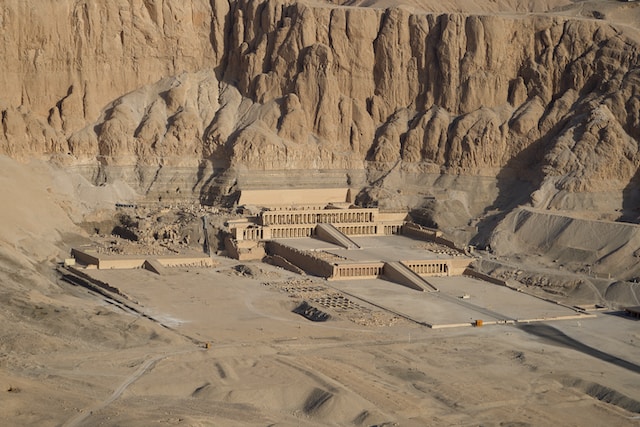
One of the greatest attractions you will come through while going on Egypt Trips is the temple of Queen Hatshepsut, known as Djeser-Djeseru, is one of the most captivating and awe-inspiring structures in ancient Egypt. Located on the west bank of the Nile River in Luxor, Egypt, this temple stands as a testament to the incredible architectural achievements of the time. Its grandeur and beauty have fascinated historians, archaeologists, and tourists alike for centuries. As you step foot into this enchanting temple, you will be transported back in time, immersing yourself in the rich history and legacy of Queen Hatshepsut.
Historical significance of the temple
The temple of Queen Hatshepsut holds immense historical significance in the realm of ancient Egyptian civilization. Built during the 15th century BC, it served as a mortuary temple dedicated to the worship of the Queen and the gods of ancient Egypt. Queen Hatshepsut was one of the few female pharaohs in Egyptian history, and her reign was marked by unprecedented prosperity and cultural advancements. The temple stands as a testament to her extraordinary rule and her efforts to solidify her place in history.
The temple’s construction was a monumental undertaking that required great resources and architectural mastery. Its design and layout were meticulously planned to reflect the grandeur and power associated with the pharaohs of Egypt. The temple’s location, nestled against the cliffs of Deir el-Bahari, adds to its allure and majesty. The walls of the temple are adorned with intricate reliefs and hieroglyphics, depicting scenes from Queen Hatshepsut’s life and the religious rituals performed within its sacred walls.
Architecture and design of the temple
The architecture and design of the temple of Queen Hatshepsut are truly remarkable. The temple is a perfect example of ancient Egyptian temple architecture, characterized by its grand colonnades, imposing statues, and intricate reliefs. The structure consists of three terraces, each rising above the other, creating a sense of grandeur and magnificence.
The first terrace is adorned with massive statues of Queen Hatshepsut, standing tall and proud, symbolizing her power and authority. The second terrace features a colonnade with impressive columns, intricately carved with images of the Queen and the gods. As you ascend to the third and final terrace, you will be greeted by the breathtaking sight of the sanctuary, dedicated to the gods of ancient Egypt.
The temple’s design seamlessly blends into its natural surroundings, with its terraces mirroring the natural rock formations of the cliffs. The use of symmetry and proportion in the temple’s architecture creates a harmonious balance that is pleasing to the eye. The temple of Queen Hatshepsut is a true masterpiece of ancient Egyptian engineering and design, standing as a testament to the ingenuity and creativity of the civilization that built it.
Discovering the hidden treasures of the temple
As you explore the temple of Queen Hatshepsut, you will have the opportunity to discover its hidden treasures and unravel the mysteries of ancient Egypt. The walls of the temple are adorned with intricate reliefs, depicting scenes from the Queen’s life, religious rituals, and offerings to the gods. Each carving tells a story, offering glimpses into the everyday life and beliefs of the ancient Egyptians.
One of the most famous treasures of the temple is the Red Chapel, an intricately decorated sanctuary dedicated to the god Amun-Ra. The chapel’s walls are covered with colorful reliefs, depicting scenes of religious ceremonies and offerings. The beauty and craftsmanship of the Red Chapel are a testament to the artistic skill and dedication of the ancient Egyptians.
Another hidden gem within the temple is the Hathor Chapel, dedicated to the goddess of love and beauty. The chapel’s walls are adorned with delicate carvings of Hathor, offering a glimpse into the ancient Egyptian’s reverence for feminine beauty and fertility. The Hathor Chapel is a serene and peaceful sanctuary within the temple, inviting visitors to reflect and connect with the divine.
The temple of Queen Hatshepsut holds many more hidden treasures waiting to be discovered. Every step you take within its sacred walls brings you closer to the ancient past, immersing you in the rich history and culture of Egypt.
The life and reign of Queen Hatshepsut
To fully appreciate the temple of Queen Hatshepsut, it is important to understand the remarkable life and reign of the Queen herself. Hatshepsut was born into a royal family, destined for greatness. As a young woman, she married her half-brother, Thutmose II, who ascended to the throne as pharaoh. After his death, Hatshepsut assumed the role of regent for her young stepson, Thutmose III. However, she soon declared herself pharaoh, breaking with tradition and becoming one of the few female rulers in Egyptian history.
Hatshepsut’s reign was marked by unprecedented prosperity and cultural advancements. She embarked on ambitious building projects, including the construction of her mortuary temple in Luxor. Her reign was characterized by stability and economic growth, as she fostered trade relationships with neighboring kingdoms and expanded the reach of Egypt’s influence.
Despite her achievements, Hatshepsut’s legacy was not without controversy. After her death, her stepson, Thutmose III, sought to erase her memory from history, defacing her statues and attempting to erase her name from inscriptions. It was only in the 19th century, with the rediscovery of her temple, that Hatshepsut’s true legacy was brought to light and the extent of her achievements recognized.
The life and reign of Queen Hatshepsut are a testament to the strength and determination of women throughout history. Her temple stands as a tribute to her remarkable rule and serves as a reminder of the power and influence that women can wield.
Exploring Luxor: A glimpse into ancient Egyptian civilization
Visiting the temple of Queen Hatshepsut is not only an opportunity to delve into the mysteries of ancient Egypt but also a chance to explore the vibrant city of Luxor. Known as Thebes in ancient times, Luxor was the capital of Egypt during the New Kingdom period and served as a center of religious, political, and cultural life.
Luxor is home to a wealth of ancient Egyptian treasures, including the world-famous Valley of the Kings and the breathtaking Karnak Temple Complex. The Valley of the Kings is the final resting place of many pharaohs, including Tutankhamun, and is a must-visit for any history enthusiast. The Karnak Temple Complex, on the other hand, is a sprawling complex of temples, pylons, and obelisks, dedicated to the worship of the gods.
Beyond its ancient wonders, Luxor offers a vibrant and bustling modern city. The bustling markets, known as souks, are a treasure trove of spices, textiles, and handmade crafts. Exploring the streets of Luxor is like stepping back in time, with its traditional architecture and friendly locals. You can also take a relaxing felucca ride along the Nile River, soaking in the beauty of the surrounding landscape.
Visiting Luxor is a truly immersive experience, allowing you to get a glimpse into the daily life and rich history of ancient Egypt. It is a destination that will leave you with a sense of wonder and awe, and a deeper appreciation for the achievements of the ancient Egyptians.
Tips for visiting the temple of Queen Hatshepsut
Visiting the temple of Queen Hatshepsut is a once-in-a-lifetime experience that requires some careful planning. Here are some tips to make the most of your visit:
- Plan your visit: The temple can get crowded, especially during peak tourist seasons. It is advisable to arrive early in the morning to avoid the crowds and enjoy the temple in peace.
- Wear comfortable clothing and footwear: The temple complex is quite expansive, and you will be doing a lot of walking. Make sure to wear comfortable shoes and dress appropriately for the weather.
- Bring sunscreen and a hat: Luxor can get extremely hot, especially during the summer months. Protect yourself from the sun by wearing sunscreen and a hat.
- Respect the rules and regulations: The temple is a sacred site, and it is important to respect the rules and regulations in place. Do not touch or climb on the ancient structures and be mindful of the signs and instructions provided by the authorities.
- Engage a knowledgeable guide: To truly appreciate the history and significance of the temple, consider hiring a knowledgeable guide who can provide insights and answer your questions.
By following these tips, you can ensure a memorable and fulfilling visit to the temple of Queen Hatshepsut.





